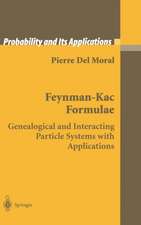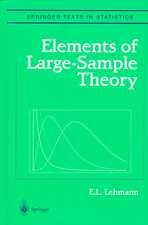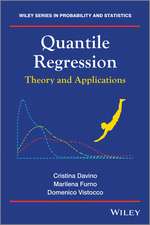Modeling Survival Data: Extending the Cox Model: Statistics for Biology and Health
Autor Terry M. Therneau, Patricia M. Grambschen Limba Engleză Paperback – dec 2010
| Toate formatele și edițiile | Preț | Express |
|---|---|---|
| Paperback (1) | 1220.12 lei 6-8 săpt. | |
| Springer – dec 2010 | 1220.12 lei 6-8 săpt. | |
| Hardback (1) | 1225.94 lei 6-8 săpt. | |
| Springer – 11 aug 2000 | 1225.94 lei 6-8 săpt. |
Din seria Statistics for Biology and Health
- 20%
 Preț: 633.23 lei
Preț: 633.23 lei - 17%
 Preț: 352.01 lei
Preț: 352.01 lei - 20%
 Preț: 776.71 lei
Preț: 776.71 lei - 20%
 Preț: 1376.32 lei
Preț: 1376.32 lei - 18%
 Preț: 1394.84 lei
Preț: 1394.84 lei - 18%
 Preț: 883.59 lei
Preț: 883.59 lei - 5%
 Preț: 843.91 lei
Preț: 843.91 lei -
 Preț: 397.16 lei
Preț: 397.16 lei - 20%
 Preț: 1002.67 lei
Preț: 1002.67 lei - 18%
 Preț: 1395.32 lei
Preț: 1395.32 lei - 5%
 Preț: 1102.10 lei
Preț: 1102.10 lei - 5%
 Preț: 874.83 lei
Preț: 874.83 lei - 15%
 Preț: 657.39 lei
Preț: 657.39 lei - 18%
 Preț: 960.93 lei
Preț: 960.93 lei - 15%
 Preț: 585.90 lei
Preț: 585.90 lei - 5%
 Preț: 852.69 lei
Preț: 852.69 lei - 18%
 Preț: 903.62 lei
Preț: 903.62 lei - 5%
 Preț: 721.40 lei
Preț: 721.40 lei - 15%
 Preț: 653.46 lei
Preț: 653.46 lei - 18%
 Preț: 2114.90 lei
Preț: 2114.90 lei - 18%
 Preț: 1108.99 lei
Preț: 1108.99 lei - 5%
 Preț: 821.39 lei
Preț: 821.39 lei - 5%
 Preț: 849.02 lei
Preț: 849.02 lei - 15%
 Preț: 653.14 lei
Preț: 653.14 lei - 18%
 Preț: 958.56 lei
Preț: 958.56 lei - 5%
 Preț: 722.69 lei
Preț: 722.69 lei - 18%
 Preț: 728.74 lei
Preț: 728.74 lei - 18%
 Preț: 943.22 lei
Preț: 943.22 lei - 5%
 Preț: 1092.43 lei
Preț: 1092.43 lei - 15%
 Preț: 594.21 lei
Preț: 594.21 lei - 5%
 Preț: 377.87 lei
Preț: 377.87 lei - 18%
 Preț: 1124.60 lei
Preț: 1124.60 lei - 15%
 Preț: 632.98 lei
Preț: 632.98 lei - 18%
 Preț: 1394.84 lei
Preț: 1394.84 lei -
 Preț: 389.11 lei
Preț: 389.11 lei - 18%
 Preț: 959.98 lei
Preț: 959.98 lei
Preț: 1220.12 lei
Preț vechi: 1487.96 lei
-18% Nou
Puncte Express: 1830
Preț estimativ în valută:
233.46€ • 244.41$ • 193.18£
233.46€ • 244.41$ • 193.18£
Carte tipărită la comandă
Livrare economică 05-19 aprilie
Preluare comenzi: 021 569.72.76
Specificații
ISBN-13: 9781441931610
ISBN-10: 1441931619
Pagini: 368
Ilustrații: XIV, 350 p.
Dimensiuni: 155 x 235 x 19 mm
Greutate: 0.51 kg
Ediția:2000
Editura: Springer
Colecția Springer
Seria Statistics for Biology and Health
Locul publicării:New York, NY, United States
ISBN-10: 1441931619
Pagini: 368
Ilustrații: XIV, 350 p.
Dimensiuni: 155 x 235 x 19 mm
Greutate: 0.51 kg
Ediția:2000
Editura: Springer
Colecția Springer
Seria Statistics for Biology and Health
Locul publicării:New York, NY, United States
Public țintă
ResearchCuprins
Estimating the Survival and Hazard Functions.- The Cox Model.- Residuals.- Functional Form.- Testing Proportional Hazards.- Influence.- Multiple Events per Subject.- Frailty Models.- Expected Survival.
Recenzii
From the reviews:
TECHNOMETRICS
"I would be curious to know how many people bought the book by Fleming and Harrington (1991) and by Anderson, Borgan, Gill, and Keiding (1993) when they first appeared hoping for an introduction to the subject. Instead we all should have saved our money and waited fir this volume by Therneau and Grambsch…This book can serve as a useful reference for statistical practitioners who encounter survival data and for researchers who want to update their knowledge in modern survival analysis…The writing style is light and almost humorous in many places. We get the feeling that the authors had a lot of fun writing this book. If only it was available a decade ago."
STATISTICAL METHODS IN MEDICAL RESEARCH
"In short, this is an exciting book, which introduces and illustrates some recent developments in surviavl analysis. The authors maintain an informal and good-humoures style, making the book very easy to read, and insist on a hands-on approach which encourages the reader to re-work examples. I would recommend it to any statistician analysing survival data."
SHORT BOOK REVIEWS
"The authors ... have laid out for us the wealth of their practical experience at all levels; the numerical aspects; computer algorithms; evaluation of different methods and connections between them; possible pitfalls; and interpretation of the results. Remarkable insights abound.
This book completes that of P. Hougaard by giving much detail on actual fitting of the models discussed by him.
It will serve two audiences: the busy practitioner who has not had time to catch up with martingale theory and counting processes and the graduate student who has just completed such a course and who needs to be introduced to the practicalities and judgements needed in data analysis. It is likely to become a well-thumbed copy on the statistician's desk and statistical practice will be the better for it."
STATISTICS IN MEDICINE
"I use S-PLUS in my own applied work and when testing my methodological research. Therefore, I came to this book with high expectations. I was not disappointed. The book is an invaluable resource for all researchers who use SAS and/or S-PLUS in their applied work, and who want to improve their skills in analyzing survival and event history data."
JOURNAL OF THE AMERICAN STATISTICAL ASSOCIATION
"…I highly recommend [this book] to statisticians analyzing survival data with S-PLUS and SAS."
"Analogous development for Cox’s regression model – stimulated partially by the counting process theory – has taken place over the last quarter of a century. This book provides a well-organized and extensive collection of these methods. … The book is reasonably self-contained. It brings the fruits of the counting process-based methods to the common analyst … . A number of biostatistical data sets have been used for the purpose of illustrative analysis. … I think thebook achieves more than its stated objective." (Debasis Sengupta, Sankhya, Vol. 65 (4), 2003)
"This book models survival data, mainly in terms of the Cox regression model and its extensions … . The text is fluently written in the style of a medium-level oral presentation which makes the book well readable and its contents well understandable … . Difficult theoretical concepts are explained in an easy, yet instructive way … . I consider this book as a most valuable source for beginners … and I warmly recommend this book as introductory reading, guidance, and reference for practical work." (Jochen Mau, Metrika, February, 2003)
"This book presents a state-of-the-art overview on modeling survival data. … examples underline the enormous flexibility and potential of the discussed models. … Appendices giving short tutorials into the statistical packages SAS and A-Plus as well as selected data sets will be very useful for most readers. … The well chosen examples, their analysis and interpretation underline the experience of the authors and makes the book a must-have for every biostatistician." (Heinz J. Skala, Statistical Papers, Vol. 44 (2), 2003)
"‘This is a book for statistical practitioners who analyse survival and event history data … .’ it is also for those who do have the theoretical knowledge already but want to know how to implement it in S-Plus or SAS … . analysis of any event data is outlined very clearly and illustrated by a lot of examples. Therefore, this book is recommended to everyone who deals with any kind of event data … . valuable guide on how to do survival/event analysis … ." (Matthias Wahl, ISCB Newsletter, December, 2003)
"This book contains a comprehensive description of what already can be found in the well-reputed S library survival 5 … . It gives an introduction to survival analysis, with emphasis on the Cox model, and with several illustrations from the authors’ practice as biostatisticians. … the book ends with… several appendices containing SAS macros, S functions and data sets. The book is a very useful companion for the practitioner of survival analysis and particularly for one who uses the Cox model and survival 5." (Göran Broström, Zentralblatt MATH, Vol. 958, 2001)
"This book presents and illustrates various failure time data analysis techniques … . the context of many of the examples seems quite interesting and each is adequately explained by the authors. … The book is clearly written … . In summary, this work is a valuable addition to the list of books on failure time data analysis. … can be recommended to data analysts wishing to try out some of the more recent failure time analysis developments." (Ross Prentice, SIAM Review, Vol. 43 (3), 2001)
"The monograph provides an excellent overview on a number of introductory and advanced topics concerning the Cox proportional hazards model. … Model features, ideas and alternatives are given … . is clearly and concisely written and theory is illustrated with lot of examples. It aims at the practitioner as it covers all practical problems. … I think that the authors have succeeded in writing an excellent monograph on practical survival analysis. It is recommended for everyone who is working in this research field." (M. H. J. de Bruijne, Kwantitatieve Methoden, Vol. 22 (66), 2001)
TECHNOMETRICS
"I would be curious to know how many people bought the book by Fleming and Harrington (1991) and by Anderson, Borgan, Gill, and Keiding (1993) when they first appeared hoping for an introduction to the subject. Instead we all should have saved our money and waited fir this volume by Therneau and Grambsch…This book can serve as a useful reference for statistical practitioners who encounter survival data and for researchers who want to update their knowledge in modern survival analysis…The writing style is light and almost humorous in many places. We get the feeling that the authors had a lot of fun writing this book. If only it was available a decade ago."
STATISTICAL METHODS IN MEDICAL RESEARCH
"In short, this is an exciting book, which introduces and illustrates some recent developments in surviavl analysis. The authors maintain an informal and good-humoures style, making the book very easy to read, and insist on a hands-on approach which encourages the reader to re-work examples. I would recommend it to any statistician analysing survival data."
SHORT BOOK REVIEWS
"The authors ... have laid out for us the wealth of their practical experience at all levels; the numerical aspects; computer algorithms; evaluation of different methods and connections between them; possible pitfalls; and interpretation of the results. Remarkable insights abound.
This book completes that of P. Hougaard by giving much detail on actual fitting of the models discussed by him.
It will serve two audiences: the busy practitioner who has not had time to catch up with martingale theory and counting processes and the graduate student who has just completed such a course and who needs to be introduced to the practicalities and judgements needed in data analysis. It is likely to become a well-thumbed copy on the statistician's desk and statistical practice will be the better for it."
STATISTICS IN MEDICINE
"I use S-PLUS in my own applied work and when testing my methodological research. Therefore, I came to this book with high expectations. I was not disappointed. The book is an invaluable resource for all researchers who use SAS and/or S-PLUS in their applied work, and who want to improve their skills in analyzing survival and event history data."
JOURNAL OF THE AMERICAN STATISTICAL ASSOCIATION
"…I highly recommend [this book] to statisticians analyzing survival data with S-PLUS and SAS."
"Analogous development for Cox’s regression model – stimulated partially by the counting process theory – has taken place over the last quarter of a century. This book provides a well-organized and extensive collection of these methods. … The book is reasonably self-contained. It brings the fruits of the counting process-based methods to the common analyst … . A number of biostatistical data sets have been used for the purpose of illustrative analysis. … I think thebook achieves more than its stated objective." (Debasis Sengupta, Sankhya, Vol. 65 (4), 2003)
"This book models survival data, mainly in terms of the Cox regression model and its extensions … . The text is fluently written in the style of a medium-level oral presentation which makes the book well readable and its contents well understandable … . Difficult theoretical concepts are explained in an easy, yet instructive way … . I consider this book as a most valuable source for beginners … and I warmly recommend this book as introductory reading, guidance, and reference for practical work." (Jochen Mau, Metrika, February, 2003)
"This book presents a state-of-the-art overview on modeling survival data. … examples underline the enormous flexibility and potential of the discussed models. … Appendices giving short tutorials into the statistical packages SAS and A-Plus as well as selected data sets will be very useful for most readers. … The well chosen examples, their analysis and interpretation underline the experience of the authors and makes the book a must-have for every biostatistician." (Heinz J. Skala, Statistical Papers, Vol. 44 (2), 2003)
"‘This is a book for statistical practitioners who analyse survival and event history data … .’ it is also for those who do have the theoretical knowledge already but want to know how to implement it in S-Plus or SAS … . analysis of any event data is outlined very clearly and illustrated by a lot of examples. Therefore, this book is recommended to everyone who deals with any kind of event data … . valuable guide on how to do survival/event analysis … ." (Matthias Wahl, ISCB Newsletter, December, 2003)
"This book contains a comprehensive description of what already can be found in the well-reputed S library survival 5 … . It gives an introduction to survival analysis, with emphasis on the Cox model, and with several illustrations from the authors’ practice as biostatisticians. … the book ends with… several appendices containing SAS macros, S functions and data sets. The book is a very useful companion for the practitioner of survival analysis and particularly for one who uses the Cox model and survival 5." (Göran Broström, Zentralblatt MATH, Vol. 958, 2001)
"This book presents and illustrates various failure time data analysis techniques … . the context of many of the examples seems quite interesting and each is adequately explained by the authors. … The book is clearly written … . In summary, this work is a valuable addition to the list of books on failure time data analysis. … can be recommended to data analysts wishing to try out some of the more recent failure time analysis developments." (Ross Prentice, SIAM Review, Vol. 43 (3), 2001)
"The monograph provides an excellent overview on a number of introductory and advanced topics concerning the Cox proportional hazards model. … Model features, ideas and alternatives are given … . is clearly and concisely written and theory is illustrated with lot of examples. It aims at the practitioner as it covers all practical problems. … I think that the authors have succeeded in writing an excellent monograph on practical survival analysis. It is recommended for everyone who is working in this research field." (M. H. J. de Bruijne, Kwantitatieve Methoden, Vol. 22 (66), 2001)
Caracteristici
Includes supplementary material: sn.pub/extras














